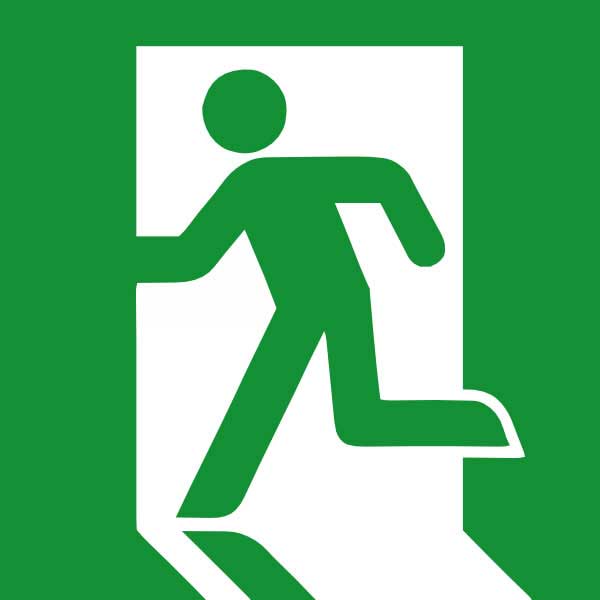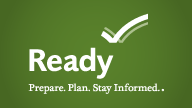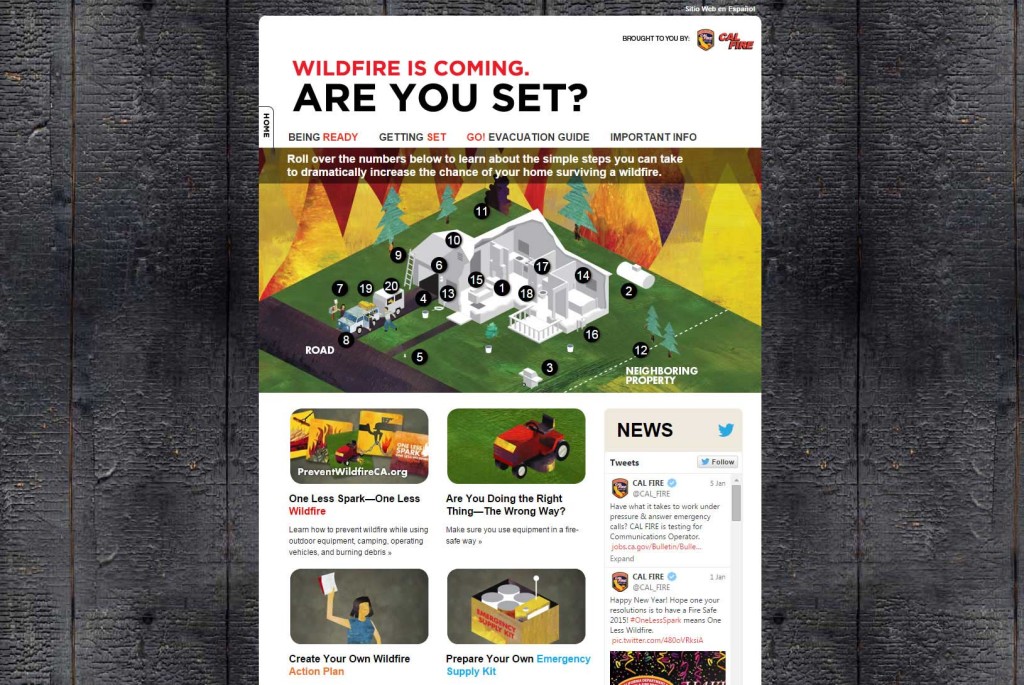ALERT: If there is an active fire in your area, click here now.
Personal preparedness, not just for a wildfire or tornado or an earthquake, but to be prepared for 24, 48, 72 hours on your own is really vital throughout the country. Natural disasters occur; that’s just the way of life. If you haven’t been affected, you will.
Emergency Preparedness Comes First
This is your first step and should happen NOW! You need to be ready to evacuate. You need to be ready to be on your own for a time.
Don’t wait until the fire or emergency is happening.
Sometimes it’s easy to get caught up in property clearance and home preparation and to forget the most important thing you can do right off the bat– get ready to evacuate.
Join us and Pledge to Prepare for Wildfire!

Family Emergency Plan
Ready.gov Has the 411 on Evacuation
The time to prepare to evacuate is now. Don’t wait until an event is already taking place or after the evacuation order has been issued. This cannot be stressed enough.
While you may never know the exact “right” time to leave, leaving early will always assure you and your family better safety.
If you only do one thing to get fire wise, this is it!
Ready.gov is an entire web site brought to us by FEMA that has checklists and step-by-step instructions for everything you need to get going. Ready.gov is completely dedicated to preparing for disasters.
The site is laid out like a giant checklist. Just follow the main links across the top once you arrive at the Ready.gov web site to get started. You’ll receive an excellent education in emergency preparedness, and the concrete steps you should take to get ready.
Click to Go to Get Started Making a Plan at Ready.gov
The Ready.gov steps are:
-
Be Informed
-
Make a Plan
-
Build a Kit
-
Get Involved
-
Business
-
Kids
Here are the individual links for your convenience. Each link opens in a new window.
- BE INFORMED: Learn what protective measures to take before, during, and after an emergency.
- MAKE A PLAN: Prepare, plan and stay informed for emergencies.
- BUILD A KIT: Build a kit for disasters to be prepared.
- GET INVOLVED: Find opportunities to support community preparedness.
- BUSINESS: Plan for and protect your business.
- KIDS: Fun and games for kids. Great tools for educators and parents too!
Make Your Evacuation Plan First
Firewise Madera County always recommends that safe evacuation be your top priority. Get ready to evacuate, and you cannot get ready too soon. The sooner the better, in fact.
We all live with the “it can’t happen to me” belief in the back of our minds. That’s a normal part of being human. We all innately believe we are immortal, teflon, bulletproof.
But it CAN happen to us, and it will.
The question is WHEN, not if, a catastrophe will strike, so there’s just no sense in taking chances with fire life safety. The Bass Lake Heights Courtney Fire of 2014 is a tragically perfect example.
So it may not happen in our lifetimes, or it may happen tomorrow. But rest assured, it will happen.
Prepare > Harden > Go!
CAL FIRE has a wildfire only evacuation guide. The link below is their colorful brochure.
Click for Cal Fire’s GET SET Evacuation Guide (PDF)
Short List: Suggested Items to Consider for Evacuation
Click for PDF checklist in a new window you can print
In the event of a sudden disaster there in not much time to react and begin to prepare for the oncoming crisis. Being prepared in the first place can make all the difference for your safety and well-being. This is the same information, with more information added, that can be found on the Go Early page.
Below is some information you will be able to use to start your preparations, along with suggestions for items to gather. This information is only a suggestion, and may be modified to suit your personal needs. There are also additional resource links to additional information.
Your personal list can be created and posted on the refrigerator. A plastic storage container can also be filled with your items and be ready and available in the event of an immediate evacuation notice.
Prepare well in advance and be ready to go!
Copies of Documents
- Insurance policies
- Passports
- Birth certificates
- Property deeds
- Other paperwork that can’t easily be accessed
Personal Items
- Medications
- Eyeglasses
- House keys
- Change of Clothes
- Cash money
- Photos
- Water
- Basic toiletries: toothbrush, toothpaste, washcloth, towels
- Cell phones
Additional Items
- Radio & flashlight with batteries
- Warm Clothes
- Blankets / Sleeping Bags
- Sun Glasses
- Shovel
Animals
- Food
- Water
- Medications
- Shelter, relocation site
Note: An evacuation center will not allow pets to be housed with evacuees. Contact animal control / rescue. See links.
Evacuations
In the event of an evacuation notice, the Madera County Sheriff’s office will coordinate the evacuation process. Notice will be given through the “Reverse 911 system”, MC Alert, or through direct contact with the sheriff’s deputies.
When an evacuation is anticipated, follow these checklists (if time allows) to give your home the best chance of surviving a wildfire:
Outside Your Home
- Gather up flammable items from the exterior of your home (decks, patios, etc), and bring them indoors or move them away from the structure. This includes things like patio furniture, children’s toys, door mats, trash cans, etc.
- Turn off propane tanks.
- Move propane BBQ appliances away from structures.
- Connect garden hoses to outside water valves or spigots for use by firefighters. Fill water buckets and place them around the house.
- Don’t leave sprinklers on or water running. They can affect critical water pressure.
- Leave exterior lights on so your home is visible to firefighters in the smoke or darkness of night.
- Put your Emergency Supply Kit in your vehicle.
- Back your car into the driveway with vehicle loaded and all doors and windows closed. Carry your car keys with you.
- Have a ladder available and place it at the corner of the house for firefighters to quickly access your roof.
- Seal attic and ground vents with pre-cut plywood or commercial seals.
- Patrol your property and monitor the fire situation. Don’t wait for an evacuation order if you feel threatened.
- Check on neighbors and make sure they are preparing to leave.
Inside Your Home
- Shut all windows and doors, leaving them unlocked.
- Remove flammable window shades and curtains. Close metal shutters.
- Move flammable furniture to the center of the room, away from windows and doors.
- Shut off gas at the meter. Turn off pilot lights.
- Leave your lights on so firefighters can see your house under smoky conditions.
- Shut off the air conditioning.
Animals
- Locate your pets and keep them nearby.
- Prepare farm animals for transport and think about moving them to a safe location early
WILDFIRE IS COMING: ARE YOU READY TO GO?!
Following is very useful information from CAL FIRE’s Ready Set Go program.
Please note that for emergency preparedness well in advance of an incident, Firewise Madera County always recommends getting your go kit and evacuation plan together first, before hardening your Home Ignition Zone.
WILDFIRE EVACUATION GUIDE
Give your family the best chance of surviving a wildfire by evacuating early.http://ReadyForWildfire.org/
Home Pre-Evacuation Preparation Steps
When an evacuation is anticipated, follow these checklists (if time allows) to give your home the best chance of surviving a wildfire:
Outside Your Home
- Gather up flammable items from the exterior of your home (decks, patios, etc), and bring them indoors or move them away from the structure. This includes things like patio furniture, children’s toys, door mats, trash cans, etc.
- Turn off propane tanks.
- Move propane BBQ appliances away from structures.
- Connect garden hoses to outside water valves or spigots for use by firefighters. Fill water buckets and place them around the house.
- Don’t leave sprinklers on or water running. They can affect critical water pressure.
- Leave exterior lights on so your home is visible to firefighters in the smoke or darkness of night.
- Put your Emergency Supply Kit in your vehicle.
- Back your car into the driveway with vehicle loaded and all doors and windows closed. Carry your car keys with you.
- Have a ladder available and place it at the corner of the house for firefighters to quickly access your roof.
- Seal attic and ground vents with pre-cut plywood or commercial seals.
- Patrol your property and monitor the fire situation. Don’t wait for an evacuation order if you feel threatened.
- Check on neighbors and make sure they are preparing to leave.
Inside Your Home
- Shut all windows and doors, leaving them unlocked.
- Remove flammable window shades and curtains. Close metal shutters.
- Move flammable furniture to the center of the room, away from windows and doors.
- Shut off gas at the meter. Turn off pilot lights.
- Leave your lights on so firefighters can see your house under smoky conditions.
- Shut off the air conditioning.
Animals
- Locate your pets and keep them nearby.
- Prepare farm animals for transport and think about moving them to a safe location early
KNOW THE LAW BE READY TO EVACUATE
California law authorizes officers to restrict access to any area where a menace to public health or safety exists due to a calamity such as flood, storm, fire, earthquake, explosion, accident or other
disaster. Refusal to comply is a misdemeanor. (Penal Code 409.5)
How to Be Prepared
Before Wildfire Strikes
Develop an Action Plan that includes:
-
Where to Go
- Have a safe destination planned. It should be a low-risk area, such as a well-prepared friend’s or relative’s house, an evacuation center, motel, etc.
-
How To Get There
- Plan several travel route options in case one route is blocked by the fire or by emergency vehicles and equipment.
-
What To Take
- Assemble your emergency supply kit long before a wildfire or other disaster occurs. Plan to be away from your home for at least three days. Don’t forget to plan for your pets or livestock as well.
For more information on preparing your family, pets and property for wildfire see the Ready for Wildfire “Are You Set?” brochure or visit ReadyforWildfire.org/set.
RETURNING HOME
After a Wildfire
Do not return to your home until fire officials determine it is safe. Notification that it is safe to return home will be given as soon as possible considering safety and accessibility. When you return home:
- Be alert for downed power lines and other hazards.
- Check propane tanks, regulators, and lines before turning gas on.
- Check your residence carefully for hidden embers or smoldering fires.
Take action immediately when wildfire strikes
Follow these steps as soon as possible to get ready to Go!
- Review your Evacuation Checklist.
- Ensure your Emergency Supply Kit is in your vehicle.
- Cover up to protect against heat and flying embers. Wear long pants,
long sleeve shirt, heavy shoes/boots, cap, dry bandanna for face cover,
goggles or glasses. 100% cotton is preferable. - Locate your pets and take them with you.
When to Evacuate
Leave as soon as evacuation is recommended by fire officials to avoid being caught in fire, smoke or road congestion. Don’t wait to be ordered by authorities to leave. Evacuating early also helps firefighters keep roads clear of congestion, and lets them move more freely to do their job. In an intense wildfire, they may not have time to knock on every door. If you are advised to leave, don’t hesitate!
- Officials will determine the areas to be evacuated and escape routes to use depending upon the fire’s location, behavior, winds, terrain, etc.
- Law enforcement agencies are typically responsible for enforcing an evacuation order. Follow their directions promptly.
- You will be advised of potential evacuations as early as possible. You must take the initiative to stay informed and aware. Listen to your radio/TV for announcements from law enforcement and emergency personnel.
- You may be directed to temporary assembly areas to await transfer to a safe location.
The terms “Voluntary” and “Mandatory” are used to describe evacuation orders. However, local jurisdictions may use other terminology such as “Precautionary” and “Immediate Threat.” These terms are used to alert you to the significance of the danger. All evacuation instructions provided by officials should be followed immediately for your safety.
What to do if you become trapped
While in your vehicle:
- Stay calm.
- Park your vehicle in an area clear of vegetation.
- Close all vehicle windows and vents.
- Cover yourself with a wool or cotton blanket or jacket.
- Lie on vehicle floor.
- Use your cell phone to advise officials: Call 911.
While on foot:
- Stay calm.
- Go to an area clear of vegetation, a ditch or depression on level ground if possible.
- Lie face down and cover up your body.
- Use your cell phone to advise officials—Call 911.
While in your home:
- Stay calm and keep your family together.
- Call 911 and inform authorities of your location.
- Fill sinks and tubs with cold water.
- Keep doors and windows closed, but unlocked.
- Stay inside your house.
- Stay away from outside walls and windows.
Go to ReadyForWildfire.org for more detailed information on all three guides to prepare for and survive a wildfire.
Ready, Set, Go!
PREPARATION GUIDES
Preparing for a wildfire starts with three simple steps: Ready, Set, Go! Keep all three wildfire preparation guides on hand as a quick reference for helping your family and property be safe in the event of a wildfire.
WILDFIRE IS COMING PREPARATION GUIDES:
Step 1:
Is Your Home Ready?
Creating defensible space
and hardening your home
against wildfire.
Step 2:
Are You Set?
Developing a Wildfire
Action Plan.
Step 3:
Are You Ready to Go?
A quick-reference
evacuation guide.
Contact Information & Links
Phone Numbers
EMERGENCY DIAL 911
Cal Fire Information Line: (209) 966-4784
http://www.fire.ca.gov/index_incidents.php
Madera County Sheriff
(559) 675-7770 * Madera
Animal Control: (559) 675-7891
Road Department: (559) 675-7811
American Red Cross: (559) 445-1000
http://www.fresnomaderaredcross.org
Board of Supervisors: (559) 675-7700
http://www.madera-county.com
Fire Stations
Unit Headquarters, Mariposa (209) 966-3622
Ahwahnee FS (559) 683-4844
Bass Lake FS (559) 683-6700
Coarsegold FS (559) 683-4823
Rancheria FS (559) 683-2322
Raymond FS (559) 689-3332
Madera County
Station # 8 Coarsegold (559) 683-8008
Station # 11 North Fork (559) 877-2600
Station # 12 Oakhurst (559) 683-4808
Station # 13 Coarsegold (559) 683-8313
Station # 14 Bass Lake (559) 642-3616
Station # 16 Ahwahnee (559) 683-4868
USDA U.S Forest Service Bass Lake District
(559) 877-2218
http://www.fs.fed.us/r5/sierra
Sierra Ambulance
(559) 642-0650
(559) 456-7800
http://www.sierraambulance.org
Wildfire Websites
National Fire Plan
Board of Forestry
Madera-Mariposa-Merced Unit Fire Plan
www.fireplan.gov
Cal Fire Ready for Wildfire
www.readyforwildfire.org
California Fire Safe Council
www.firesafecouncil.org
Eastern Madera County Fire Safe Council
www.maderafsc.org
Federal Emergency Management Agency
www.fema.gov/hazards/fires/wildfires.shtm
Firewise Madera County
http://cascadelranchfiresafecouncil.org/
National Firewise
www.firewise.org
California Fire Alliance
California Fire Alliance
CERT (Community Emergency Response Team)
http://www.citizencorps.gov/cert/
Renter’s Guide
The Ultimate Safety Guide
NEWS MEDIA OUTLETS
http://www.ksee24.com/
http://www.kmph.com
http://www.cbs47.tv/default.aspx
http://abclocal.go.com/kfsn/index
Your best shot at surviving a major wildfire ripping through your neighborhood is to not be there. You, your family, your loved ones, your pets, and your neighbors, cannot be injured if you are simply not there. This is the essence of “prepare and go early”. Be prepared well in advance and be ready to go!
Click Here for Cal Fire’s GO Wildfire Evacuation Guide (PDF)

